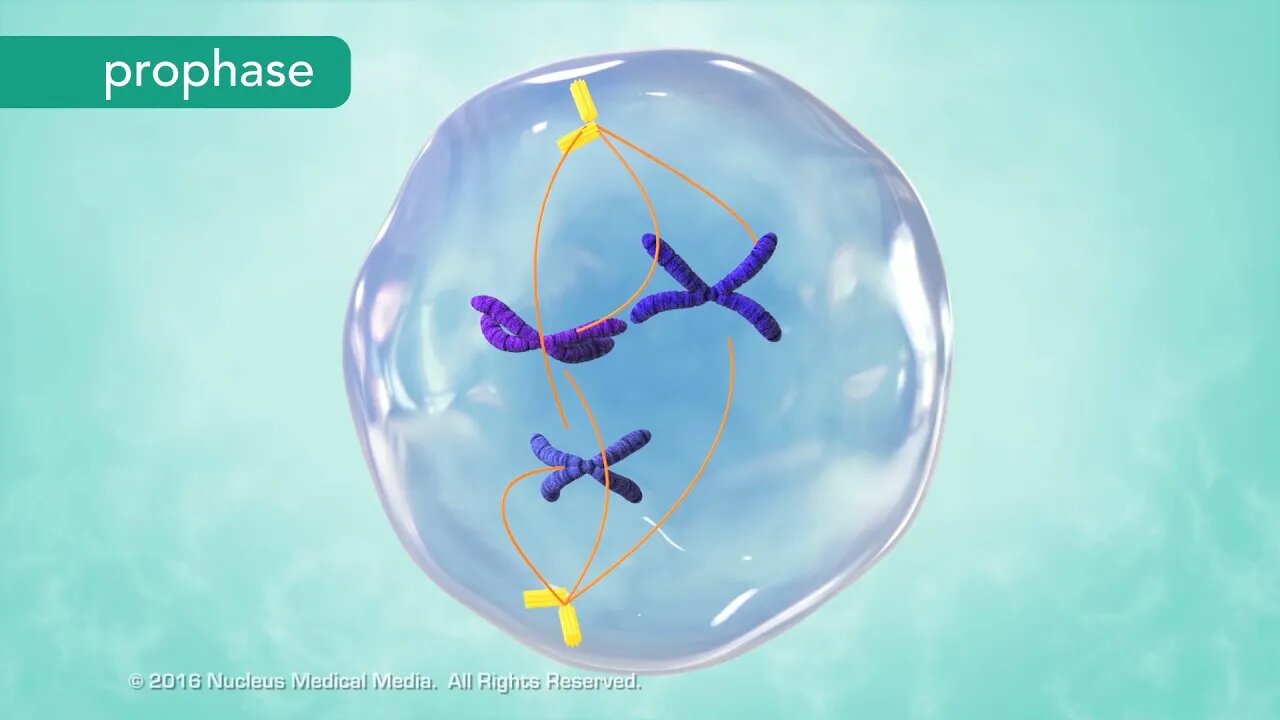Premium Only Content

M Phase of the Cell Cycle
For Employees of hospitals, schools, universities and libraries: download up to 8 FREE medical animations from Nucleus by signing up for a free trial at: http://nmal.nucleusmedicalmedia.com/biology_youtube
SCIENCE ANIMATION TRANSCRIPT: In this lesson, we'll be exploring the M phase of the cell cycle including mitosis and cytokinesis. Let's do a quick review of the cell cycle to see where they fit in. The G1, S, and G2 phases make up interphase, and the M phase represents cell division. Cell division includes division of the nucleus, called mitosis, and division of the cytoplasm, called cytokinesis. Mitosis is further broken down into four phases: prophase, metaphase, anaphase, and telophase. Prophase is the longest phase of mitosis. Prophase is when chromatin begins to condense into the shape of chromosomes, and the nucleolus disappears. The previously replicated DNA coils tightly into sister chromatids. For the first time, you see individual chromosomes. In the center of each chromosome, a centromere attaches the sister chromatids together. Meanwhile, in the cytoplasm, microtubules known as spindle fibers begin to fan out from two sets of paired structures called centrioles. The spindle fibers elongate as the centrioles begin moving to opposite sides, or poles, of the cell. While this is happening, the nuclear membrane surrounding the nucleus disappears. Now that chromosomes are no longer separated from the cytoplasm, the opposite ends of the spindle fibers can attach to the centromeres. Next, the cell enters metaphase. The centrioles complete their movement to the poles of the cell while the spindle fibers line up the chromosomes along the equator of the cell. The end-to-end alignment of chromosomes results in a sister chromatid on either side of the equator. Anaphase follows metaphase. During anaphase, spindle fibers separate the sister chromatids at their centromere. Once separated from each other, each chromatid is called a chromosome. The single-stranded chromosomes form a V shape as the spindle fibers shorten and drag them through the gel-like cytoplasm. The chromosomes move to opposite poles of the cell toward their centrioles. It's common to confuse centrioles with centromeres which connect chromatids. Remember, centrioles are at the poles. Telophase is the final stage of mitosis. In telophase, a nuclear membrane re-forms around each set of chromosomes. Then the chromosomes spread out into chromatin, and the nucleolus becomes visible once again. Mitosis, the division of the nucleus, is now complete. The final step of the M phase is cytokinesis, the division of the cytoplasm. In animal cells, cytokinesis occurs through the inward movement of the cell membrane. This progressively pinches the cytoplasm until two identical daughter cells form. In contrast, plant cells can't pinch in two because they have a rigid cell wall surrounding their cell membrane. Instead, cell wall material assembles along the equator forming a structure called the cell plate. The cell plate grows until it joins with the existing cell membrane, separating the two halves of the cell into daughter cells. Over time, new cell walls form between the two daughter cells. Here are the key points to remember. The M phase is the fourth and final phase of the cell cycle. During the M phase, cell division occurs through two processes: mitosis, when the nucleus divides, and cytokinesis, when the cytoplasm divides. Mitosis has four phases. During prophase, chromatin condenses into chromosomes, spindle fibers form, and the nucleolus and nuclear membrane disappear. During metaphase, spindle fibers align the chromosomes along the cell equator. In anaphase, the spindle fibers separate sister chromatids into two separate groups of chromosomes, pulling them toward the poles. And in telophase, the nucleolus and nuclear membrane re-form. The chromosomes disperse into chromatin. Cytokinesis is division of the cytoplasm. The M phase is complete after cytokinesis occurs. The M phase of the cell cycle always results in two daughter cells. Both of these daughter cells are identical to each other and identical to the original cell that underwent mitosis. [music]
NSV15006
-
 2:04:40
2:04:40
Steven Crowder
5 hours agoWar Criminal Pete Hegseth: Debunking the Media's Newest BS Smear Campaign
412K253 -
 59:57
59:57
The Rubin Report
4 hours agoPress Gasps When Told Trump’s Brutal Plan for Venezuela
45.3K83 -
 4:19:56
4:19:56
Benny Johnson
4 hours ago🚨Trump Cabinet Meeting LIVE Now in White House As Somali Fraud EXPOSED, Third World Deportations
85.5K58 -
 1:16:36
1:16:36
Sean Unpaved
2 hours agoAbdul Carter BENCHED In First Quarter AGAIN | UNPAVED
9.38K -
 2:20:37
2:20:37
The White House
4 hours agoPresident Trump Hosts a Cabinet Meeting, Dec. 2, 2025
34.3K26 -
 6:37
6:37
The Illusion of Consensus
2 hours agoJoe Rogan DM’d me out of the blue. This is what he said…
7.07K3 -
 22:38
22:38
Professor Nez
3 hours agoTrump Just Made his MOST IMPORTANT Decision as President
23.3K8 -
 1:38:26
1:38:26
The Shannon Joy Show
3 hours agoWar With Venezuela * Bipartisan Push For Digital ID For Children * LIVE Exclusive Interview With Freedom Advocate Alec Zeck
11.2K7 -
 1:49:57
1:49:57
The Mel K Show
3 hours agoMORNINGS WITH MEL K - America at a Crossroads-Are the People Awake Yet? 12-2-25
16.3K4 -
 49:58
49:58
Grant Stinchfield
3 hours ago $0.36 earnedGov. Tim Walz Scandal EXPLODES: Millions in Minnesota Fraud Linked to Overseas Terror Groups
6.92K7